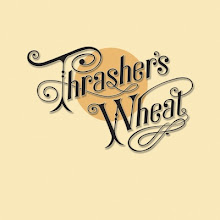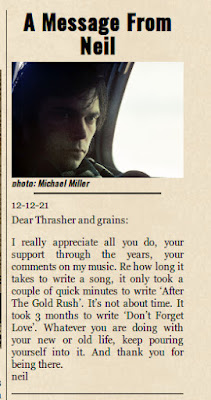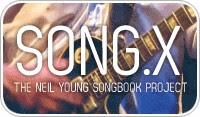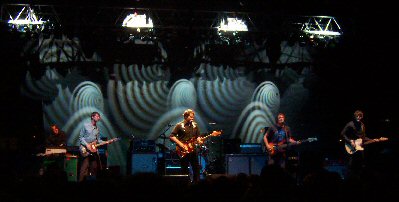Anatomy of Neil Young’s ‘Old Black’ Guitar

Universally amongst fans, Neil Young's guitar ‘Old Black’ is the stuff of legends.
From the crunchingly brutal Crazy Horse feedback fests to this year's solo electric, the Gibson Les Paul guitar has played witness to the full range of Neil's ragged glory. So if you're interested in the anatomy of Neil Young’s ‘Old Black’, check out Gibson News - Neil Young’s ‘Old Black’ Magic by Ted Drozdowski.
Here's a clip on the “wheat stack” that caught our eye in particular:
There is speculation about the year of “Old Black”’s neck. It has a partially painted-over pearloid inlay on its headstock that appears to be a “wheat stack” rather than split trapezoid style. The “wheat stack” inlay was applied to Gibson necks made between 1961 and ’68, well past “Old Black”’s vintage. Of course, most of the paint is off the back of the guitar’s mahogany neck after decades of brutal and beautiful playing, and the binding is equally frayed. Also, there’s another aluminum plate in the rear, just under the bridge to access the bridge screws from behind.
All of which reminds us of an incredible story posted awhile ago by Geoff:
I feel compelled to offer some history on this instrument.
I saw (and met) Neil the last Sunday of his opening week with Crazy horse at the Troubadour in LA, April 1969 with a friend named Jennifer Starkey... back when Old Black was Young!
The guitar was traded from Jim Messina in 1968 for a Gretsch and used on Neil's first solo album and the 'Everybody Knows This Is Nowhere' LP. I have vivid memories on how the guitar was decked out that night and can verify most of it with a photo from an old poster.
The details are as follows:
*The instrument was a beautiful gloss black with an old punch-print tape strip above the pickups that read: 'It ain't easy bein' a fuckin' indian!'
*The bigsby was a B-3 model (like a B-7 without the under-strung tension bar)
*The stop-bridge holes and bushings were open, and still are.
*The bridge coil was an old black face Rowe DeArmond M5A single coil as found on 50's Gretsches and Guilds. (This coil was left for repairs at a shop that folded and the coil disappreard. For a short time the LP was fitted with a Gretsch Filtertron but was replced in '72/'73 with a Firebird coil and the current B-7 Bigsby.)
*At that time the headstock was indeed nicely bound with creme binding and, even then, sported the Gibson crown inlay.
*The tuning machines were Grover N-102 roto-matics.
He played the first set with Crazy Horse (Danny Whitten using Neil's Gretsch 6120 and both of them using Fender Bandmasters reworked for overdrive by a guy named Randal!) But the second set Stephen Stills showed up and the two of them drank champagne, played their Martins, and sang just about every Buffalo Springfield song ever written.
All that was missing was Richie!
Quite an evening...
Geoff
Good memory Geoff! You don't see that much accuracy coming back from '69.

Guitar Tech Larry Cragg with ‘Old Black’
More photos and articles on Neil Young's guitars.































 Human Highway
Human Highway

















 Concert Review of the Moment
Concert Review of the Moment





 This Land is My Land
This Land is My Land

 FREEDOM In A New Year
FREEDOM In A New Year









 *Thanks Neil!*
*Thanks Neil!*




![[EFC Blue Ribbon - Free Speech Online]](http://www.thrasherswheat.org/gifs/free-speech.gif)











 The Unbearable Lightness of Being Neil Young
The Unbearable Lightness of Being Neil Young Pardon My Heart
Pardon My Heart



 "We're The Ones
"We're The Ones  Thanks for Supporting Thrasher's Wheat!
Thanks for Supporting Thrasher's Wheat!




 This blog
This blog 
 (... he didn't kill himself either...)
#AaronDidntKillHimself
(... he didn't kill himself either...)
#AaronDidntKillHimself









































































 Neil Young's Moon Songs
Neil Young's Moon Songs




 Civic Duty Is Not Terrorism
Civic Duty Is Not Terrorism Orwell (and Grandpa) Was Right
Orwell (and Grandpa) Was Right


 What's So Funny About
What's So Funny About 



15 Comments:
This comment has been removed by the author.
Thrasher, some additional info I have picked up from years of researching guitars:
The licensing agreement between Gibson and Les Paul was allowed to lapse in the early 60s, and after this point gibson was not able to use the Les Paul name anymore. As any gibson player knows, the headstocks on these guitars are fragile and susceptible to breakage. Also, if an instrument is dropped, the neck could crack or break off at many locations. Most of the time, the necks can be repaired, but sometimes a replacement is the only solution. There are several examples of 50s les pauls that were renecked in the 60s, and these instruments feature the wheat stack inlay, like on Old Black.
When instruments were sent in for work such as this, it is not uncommon for other modifications to be made at that time. This is probably the explanation for the extra binding around the headstock.
Many people also wonder about the small switch on Old Black. According to the videos made during the living with war period, this switch allows Neil to bypass the controls on the guitar and send the output from the pickup (not sure if this is both pickups or just the bridge) directly to the amp. The potentiometers in a guitar load the signal down, resulting in a loss of treble and a small loss of gain. A bypass switch such as this is an easy way to add a little bit more bite and gain.
Now if we could only figure out what the extra toggle switch covers are for????
Glad to have you back thrasher!!!
And here I am again!
Old black is Gold!
somewhere I've read that Ol' Black began life as a '53 Goldtop...
I have been obsessed with Old Black for years. Definitely the coolest guitar in existence, in my opinion. I love it so much that I did this painting to highlight some of its most unique parts. Please check it out, and I hope you like it.
http://www.lespaulforum.com/forum/showthread.php?t=168492
I plan on doing one of Hank in the near future to continue the Neil collection.
Keep on Rockin'
-Dylan
The description of the "young" Old Black is very innaresting and agrees very well with other accounts and photos. Old Black has been an obsession of mine for about 5 years - since I built (from scratch) a copy. In the intervening years, I have tried to "fill in the blanks", if you will, and made some modifictations to the original. Even so, there are some mysteries (still!). I used to think it was plausible that Old Black was not a '53 gold top but a 68 gold top Deluxe - the first batch produced during this year were routed for minihumbuckers (same route as a p90) and had the wheatstack inlay on the peghead. I now believe this to be unlikely. Larry Cragg has insisted its a 53 gold top and has discussed the lower neck angle of the 53 and its relationship to the B7. I think it probably was renecked (the Deluxes did not have headstock binding. The binding has been pulled off - not sure when. But what is innaresting is that even with the binding off, it is still sort of "white" because the peghead is holly veneer and not the modern black fiberboard. This is a good indication that it is a 50's-60's neck. I would still like clarification on the origin of the skunk stripe white binding (when, who, why?) and what the hell is behind the second round control cover on the back. What I wouldn't give for 5 minutes with the real Old Black and a screw driver! Also, what year is the Firebird pickup (want to know about potting and the microphonics)? What is the metal and plating of the pickguard? Is the neck binding scalped to the frets or did that go bye-bye when Larry refretted (and then undid the refretting) the neck? Gotta love the mystery!
Old black, I would really like to comment on the skunk stripe white binding....but I made a promise to Thrash after the resurrection or the 2nd coming that I would never be inane and innocuous again.
my apologies
doc
p.s.seriously, I would dearly luv to be able to play guitar and I admire your obsession to something you guys obviously luv..each to his own I say
I THINK Neil ( Larry Cragg)said the bypass switch is for the Firebird pick-up only...and (not that anyone has yet) *I* wouldn't argue with anything Larry Cragg sez about the guitar, although even HE could be wrong at some point I guess...
trying to picture Messina using a White Falcon...can't...
How could you ever leave that night behind....you go to see Neil, Stephen shows up and they play Springfield tunes on old Martin's.....how could you go home after that?
Posting again as i forgot to tick the email to follow ups box - doh!
what are the neck specs of old black?? 50s? 60s? slim? fat? wider than normal of normal width?
thank you
Dw
Does he ever use the neck pickup? All pics I find look like the toggle is down.
Listen to Country home, you'll see
I've recently read that the black guitar may be a prototype Custom- meaning made in '53, since Customs were first released in 1954. I don't know how this theory holds up with the trapeze holes, etc. Part of the reasoning probably has to do with the bound headstock, unusual headstock inlay, etc. Now- why I'm here: In 1988, my friend Kenny Aaronson was playing bass with Bob Dylan. I lived in San Francisco and they were doing the Greek Theater over in Berkeley. I went over and spent the day/night with them. Neil was there- he was going to sit in with Bob that night. So, after soundcheck, Neil was sitting with Ol Black in his lap. I mentioned a couple of mutual friends, and we got to talking. I asked about the guitar, since it's so unusual, and he gave me a mini-tour of the guitar. He's not really a "vintage guy" so we didn't really get into specifics. The thing that struck me most was the obvious thing that you guys don't mention. WHICH IS THE STRIPE DOWN THE BACK OF THE NECK! I think I saw a reference to it in a comment above, including the possibility of some derision. Well, I can take it, if it answers my question. I should have asked him, but G.E. Smith came over and started asking questions too. I assumed that the neck was a replacement- it appeared to have a herringbone, or some such, running down the back of the neck. As a 20- year veteran of the vintage guitar world [20 then, 50+ years now] that stripe could only mean a re-neck. Now, in the photo above, I see the stripe running through the body as well. Looking back, Neil was holding the guitar in playing position, and I didn't see the back of the body. This guitar has bothered me since that day in '88. Once in a while I go looking for information on information on it, but no one ever references the stripe. I was starting to doubt my recollection. WHAT IS IT AND HOW DID IT GET THERE? Please help a vintage brother out, and tell me what you know. And Thank You so much!
That's my comment above. I was also good friends with Rick Rosas. He was a wonderful guy- very funny, smart, great cook, GREAT bass player. He also played with Waddy's band in LA. And, of course, he played with Neil. Neil had no problem with Rick running his video camera during rehearsals, or whatever they were doing. So I got to watch dozens of hours of their practices, jams, whatever. He would put them on as background whenever we were doing stuff at the house. I came to really like, and respect Neil through all of that exposure. So Thank You, Rick RIP
Post a Comment
<< Home